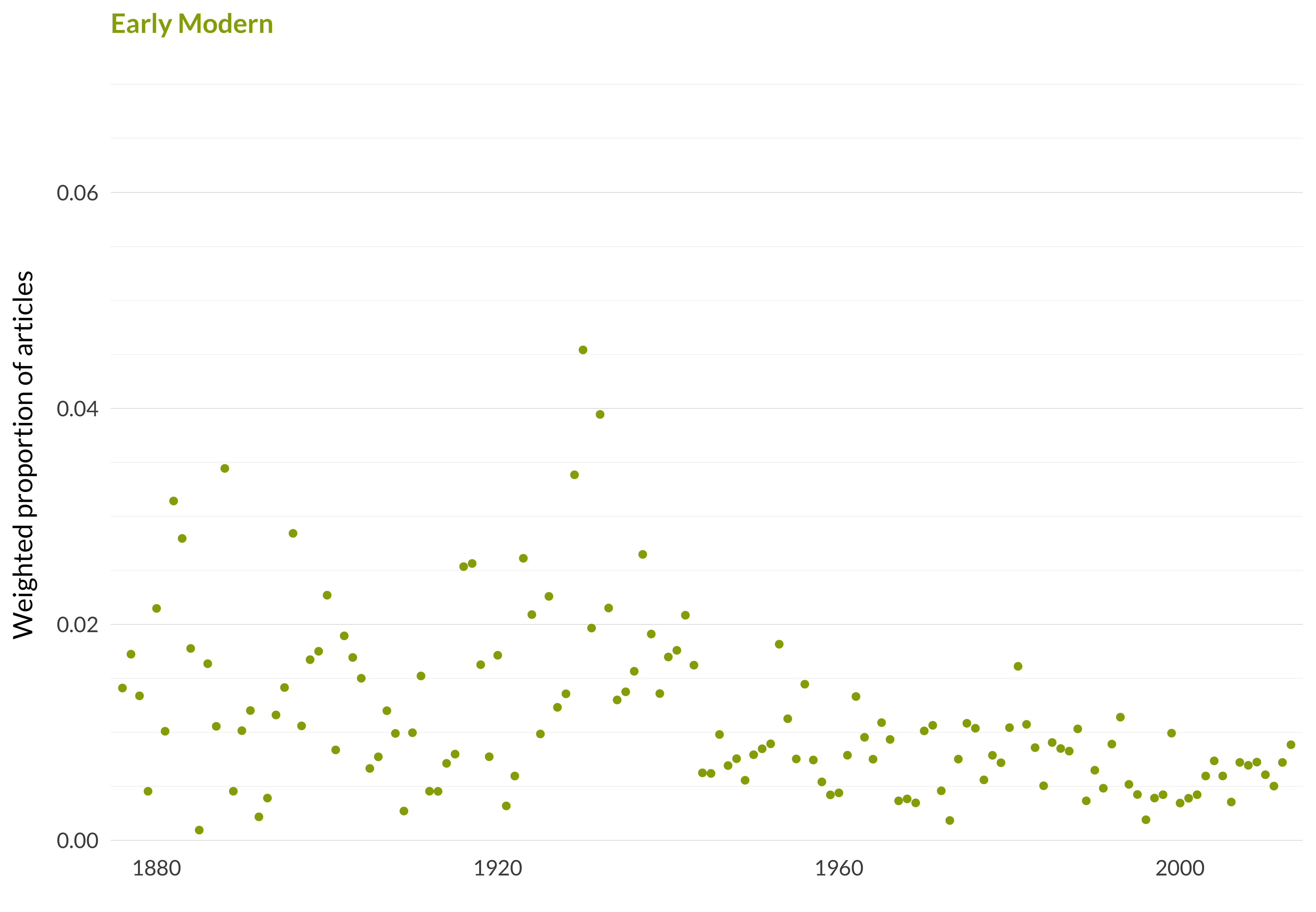2.21 Early Modern
Category: History of Philosophy
Keywords: descartes, spinoza, leibniz, cartesian, substance, substances, intellect, vii, ideas, attributes, modes, doubt, attribute, innate, berkeley
Number of Articles: 398
Percentage of Total: 1.2%
Rank: 32nd
Weighted Number of Articles: 292.2
Percentage of Total: 0.9%
Rank: 49th
Mean Publication Year: 1960.5
Weighted Mean Publication Year: 1959.5
Median Publication Year: 1963
Modal Publication Year: 1981
Topic with Most Overlap: Idealism (0.0463)
Topic this Overlaps Most With: Ontological Argument (0.0214)
Topic with Least Overlap: Formal Epistemology (3e-04)
Topic this Overlaps Least With: Game Theory (0.00011)

Figure 2.54: Early modern.

Figure 2.55: Early modern articles in each journal.
Comments
This is the main topic the model finds on early modern metaphysics and epistemology. It is a little bit centered on the rationalists; the characteristic articles are all on broadly rationalist figures. But that’s largely because the model wants to hedge its bets on articles about Locke. Topic 31 will be on social contract theory, and Locke will play a major role in that obviously. So while this topic has twenty-eight articles with “Locke” in the title, all on his metaphysics and epistemology, the model is a little nervous about whether it should be putting those in with the other Locke articles in social contract theory. So that’s why the characteristic articles are mostly about rationalist philosophers.
The big story here is the collapse in this category when Ryle takes over Mind in 1947. According to D. M. Hamlyn, who edited Mind after Ryle, Ryle thought the only history worth publishing was Greek philosophy. As Michael Kremer pointed out to me, that’s hard to square with the fact that Ryle published on several figures in history, including in early modern. Indeed, the first volume of his collected papers (1971) consists entirely of history papers, and only a few of these were in ancient philosophy. The volume includes two papers on Locke and one on Hume, so it’s not as if he thought those figures should be ignored.
But in fact once he took over at Mind, a relatively thriving tradition of that journal publishing articles on early modern came to a complete halt. Apart from Philosophical Review, and to a smaller extent PPR, that put an end to articles in early modern turning up in the twelve journals I’m looking at. I don’t have a good theory about why Ryle did this, and it’s possible it was a policy handed down to him, but it is a striking fact about Mind’s publication record.
One quick point about the list of highly cited articles. The method I used for generating the list of highly cited articles only individuated articles by title, journal and publication year. I thought that would be enough, but it turns out journals used to publish two part articles without individuating the parts. So we get results like this one; I don’t really know which of them is really cited the most. It’s possible that neither part on its own is cited enough to deserve a spot here, but merging the citations got it into the list. In future work I hope to look more closely at citation data, and then I’ll have to be more careful about cases like this one.